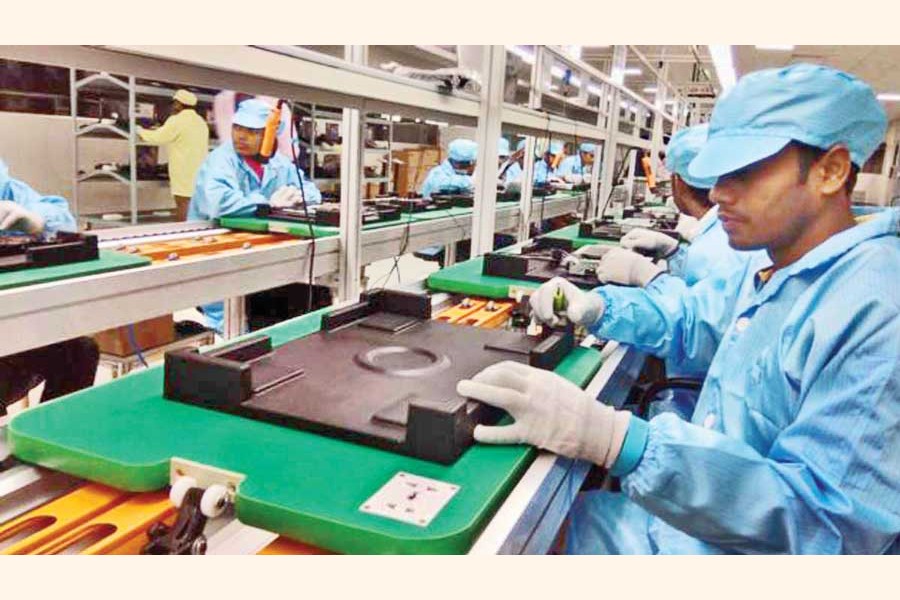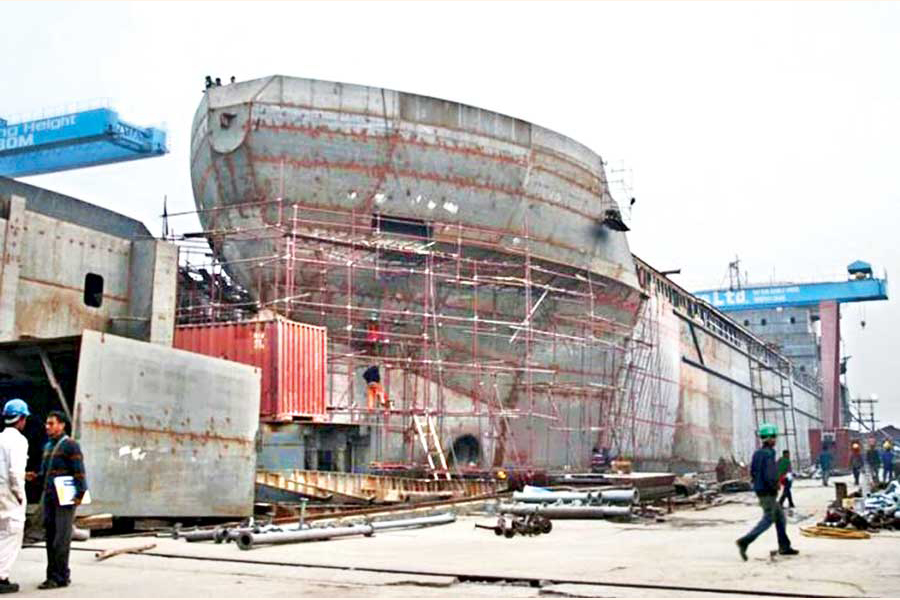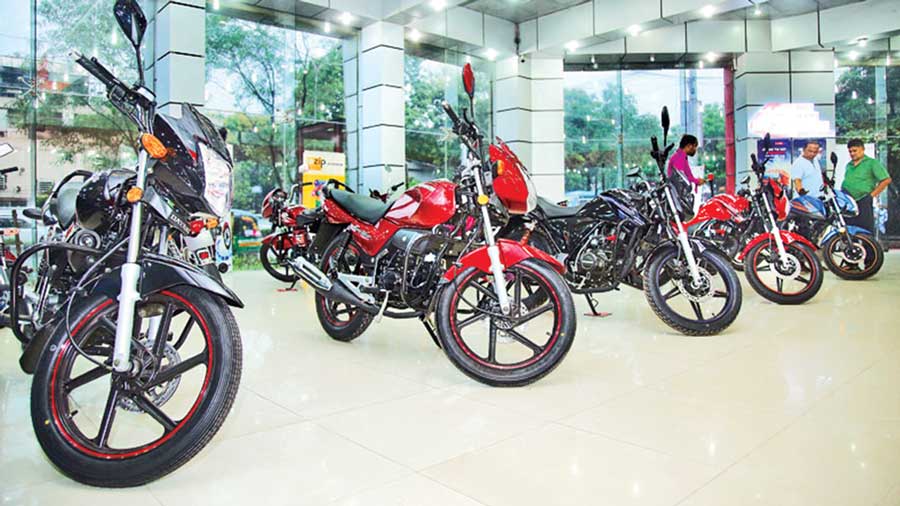
Diversification
An economic necessity
Imtiaz A Hussain | Wednesday, 13 November 2019

 Transiting from 'less developed' to 'middle-income' economic identity involves far more than celebration and vindication mindsets. It requires meticulous planning, even as any upward mobility simultaneously demands diminishing government intervention.
Transiting from 'less developed' to 'middle-income' economic identity involves far more than celebration and vindication mindsets. It requires meticulous planning, even as any upward mobility simultaneously demands diminishing government intervention.
Another window opens up for Bangladesh in this transition: it can review and reflect upon other cases of economic diversification, and from their experiences, even help build a meaningful trajectory. In essence, public-private partnerships, transparency, and fulfilling growing demands of an affluent society, with enough steam left for the growth escalator to keep climbing, propel this transition.
Indeed, to begin any transition assessment, one must identify what kind of transition is being discussed, and if it is economic transition, then what type the subject happens to be. The above examples, of 'less developed' and 'middle-income', happen to be net evaluation. Too many components go into calculating those equations to mention here, but it is fair to identify some of them.
There is the industrial one, which presumes a low-wage manufacturing start, but requires diversification discussions typically at more elevated stages: only with the maturity of our low-wage ready-made-garment (RMG) era have we begun discussing diversification, that is, more than a generation after the RMG magic tipped jute export income as the country's largest (with jute dominating exports for a couple of previous generations). How we gracefully but necessarily exit this phase is the key to opening multiple other windows: What other industry will supply the jobs to as great a degree, if not more? How will that industry earn as much foreign exchange as the RMG era fetched? Why must the wage-structure change, as those fearful of diversification often resist?
Notice how the diversification arena changes with each question-the first involving industries, the second wages, and the third exports. Diminishing jute returns in the mid-1970s led the World Bank to warn us of how emergent synthetic fibers would decimate natural counterparts. If the plastic peril was as big a piece of news then as it is now, we, both buyers and producers, may have been less reluctant to make the change we did (given how garments have devoured the planet's sustainability capacities); but that might have imperiled our under-development exit.
Choices have to be made; and apparently fortune was on our side with that transition, as it must also be today, since planning has not, as yet, proved a game-changer: the RMG industry has shifted too heavily away from natural fibres into polymer-built (polystyrene, for example, in every synthetic plastic), and the like, all too non-biodegradable for us to maintain a straight honest face globally, and all exposing the lack of any foresight or regulations.

A ship building yard at Chottogram — Collected photo
Yet, the 1974 Multi Fibre Agreement (MFA) terms proved fortuitous: it put quotas on least developed country (LDC) textile exporters, gave Bangladesh so many advantages owing to its poverty (as too the MFA evaporation in 1994, when our RMG sales boomed yet again); above all, it pushed South Korea's Daewoo to Dhaka to explore off-shoring from 1979. This was the spark that gave us an RMG identity: many Bangladeshi Daewoo trainees returned from South Korea and opened their own RMG factories.
Breathtaking macro-level changes must confront micro-level adjustments. For example, profit-generating traditional factories must make way for new production, a dilemma staring us in the face today: the Bangladesh Garment Manufacturers and Exporters Association (BGMEA) begrudgingly reformed factories after 2014 to satisfy the post-Tazreen, post-Rana Plaza European-anchored Accord buyers group and the US-rooted Alliance groups. The greater BGMEA challenge may still lie ahead: whether to substitute labour for robots, and herald automation instead.
Low-waged as it already is, the RMG industry helped us experience the first technological mastery on a wide-scale, filling our depleted treasury with more than needed hard cash, and feeding the momentum towards gender emancipation, albeit unwittingly. Market purchasing power expanded, as flocks of women entered the market, but we must still fasten our seat-belts. Based on research by the Bangladesh Institute of Development Studies, the Bangladesh Bureau of Statistics, and Center for Policy Dialogue, the female RMG proportion has plunged to 50-60 per cent today from 56-65 per cent only 10 years ago and 80-per-cent+ in the early 1990s.
Our exposure to higher-end products climbed unwittingly too, eventually evident in the home-appliance market, furniture, and topping them all off, automobile purchases sky-rocketing. Widening trade imbalances may be logical at this developmental stage, but it also calls for rethinking options and recalibrating priorities, given the growing gaps: in the 1990s, as per CEIC Data, the country's trade deficit was invariably less than $500 million per month, but tripled by the time of the Great Recession (2008-11), under $1.5 billion, while soaring beyond $2.5 billion monthly today.
Inherent in our consumer behaviour is the exposure to, addition of, and increasing demand for new technology. Thus one foot has already been exiting the low-waged, basic industrial foothold. If we look around us, we will notice how heavier industries have sprawled, assembling automobiles, building ships, and wading into home-appliances, like refrigerators. Take motorcycles, for example. From importing virtually all of them, we today assemble or manufacture virtually all. With more than a dozen different models available (from India, Japan, and other countries), the half-million units annually produced is on a growth-spurt.
A similar success story is with refrigerators, where also the quick shift from importing all we needed to local production has been accompanied by double-digit annual growth. Here, too, foreign enterprises and local entrepreneurs have doubled production, and, as with motorcycles, shifted completely to manufacturing from assembling them.
From opening an automobile assembly plant in 2007 in Mymensingh, Bangladesh has been identified by Germany's BMW and Mercedes-Benz as possible assembly-production sites in the near future. This could be a big 2019 breakthrough, after Ambassador Peter Fahrenhollz informed our Finance Minister AHM Mustafa Kamal of it earlier this month.
Shipyards in the Chattogram region have also drawn global attention. In fact, Bangladesh is already exporting mostly medium-sized vessels (with a maximum deadweight tonnage, DWT, of 15,000), to a dozen-odd countries as close as India, but also as far away as Germany, the scope to expand sales beyond $1 billion annually is promising. As a labour-intensive industry, shipbuilding and automobile-assembling could be a much-needed alternative to any RMG shift, but also pushing manufacturing up the technological ladder when it is needed the most.
Though we have barely touched the tip of these industrial-growth icebergs, we already see, if we must be explicit, the export diversification potential and technological diversification possibilities: the latter not just from the low-end to the high within the manufacturing domain, but also from that hardware arena to software. Apparently we have the labour pool to continue feeding world demand on both these fronts, still at the most competitive level. Information and Communications Technologies (ICT) State Minister Zunaid Hossain Palak envisions our ICT work-pool will double to two (02) million in two (02) years from now (by our 50th Anniversary), when it took a decade to build the first million. He has over 28 ICT parks on the drawing board presently, the Info-Sarker Project is training over half a million government employees for an e-tech conversion, but most eye-raising was his hope that the $1 billion we export today will multiply to $5 billion by that 50th Anniversary, and with it, the 40 importing country-list would also expand. The South Korean Ambassador, too, informed the same minister of his country opening up an ICT factory here (much like his country began the RMG boom in 1979). In other words, the software world is hanging outside our window, if only we have the will to hop on and go for a profitable ride.
Hurdles prevail. A Miliken Institute report five years ago pointed out major 'barriers' to Bangladesh's industrial diversification (see Industrial Diversification in Bangladesh: Opportunities and Challenges, 2014; and Asian Development Bank, Bangladesh Consolidating Export-led Growth: Country Diagnostic Study, 2016, ch. 2).): lack of power and infrastructure; regulatory uncertainty and lack of transparency; insufficient capital; and insufficient skilled labour. It also recommended (a) overseas incentives; (b) simplification of policies and regulations; and (c) accountability in issuing and enforcing legislations.
Some of the problems are being addressed (infrastructure-building), and some recommendations are already in place (improving business-ranking status globally). Our entrepreneurs can help fill up other gaps in this narration. First, they will have to forego the noblesse-oblige benefits of being under-developed in global commerce: the poor-country pity clauses in many developed countries will now disappear. In turn, a second transitional need will surface as quickly as an eye-blink: the need to ramp up domestic policies to global levels, an abstract reference to the hardcore realities of displacing government regulations upon industries, the need to be more transparent as elsewhere outside, and to subscribe more vehemently to a string of corollaries, beginning with upward wage-movements, shifts from wage-workers (the blue-collar adage) to salarimen (the white-collar counterpart, the term being Japanese), terms of employment, and ultimately health benefits, communications easing, and particularly the decline of patronage economics in place of market counterparts.
In turn, these will demand the country shift its spending to healthcare, just to set the minimum standards corporations must meet, infrastructure-building, if not to ease bottlenecks in factory-market flows, then to speed even regular communications, and with both of the above, a long string including housing, more upper-echelon and diversified food consumption, recreational facilities, educational/training institute, and so forth.
Facilitating these enormous changes, which just do not come overnight, nor with the brush of a business hand, the country's technological upgrading must be kept at all costs, if it is to reap the comparative advantage of the still globally-low wages. Sure the upward wage climb cannot be stopped, but the higher it gets, commensurate with the technological advances Bangladesh makes, more must be spent not just on primary and secondary education, but tertiary education, of the type that may improvise and innovate at the global level.
Paul R Daugherty and H James Wilson insist how 'new jobs' will be in the form of 'trainers', 'explainers', and 'sustainers', meaning, not all jobs will need tech-savvy skills, and indeed, if automation kills jobs, even more could be created ("AI can help us live more deliberately," MIT Sloan Management Review, vol., 60, no. 4 Summer 2019). The need to put our thinking-caps on cannot be higher, but the capacity to articulate effectively may become the game-changer.
These might be protracted, exorbitant, and unavoidable sideshows of any industrial diversification, but they are fundamental to the export- and technological-diversification any middle-income country needs. Yet, we must not abandon the economic ship of this transition for issues that are more cultural, social, and intellectual.
Another useful window of Bangladesh's diversification transition from low- towards high-wage is the number of global cases it can glean from, if not to improve on external examples, then to avoid the pitfalls. It is in transitions like this that the warden must pay more attention to pitfalls, which could nip the bud of changes as it matures, than the promises.
Over the past century we have seen at least two types of trade-related development formats: import-substitution-industrialisation (ISI) versus the export-led growth (ELG) strategies. Curiously both have been tainted by the emotions of the time than reflecting planning ministry strategies: to promote infant-industry growth, newly independent countries have ridden the nationalist wave that brought independence to promote import-substitution, that is, use primary-product exports (like agricultural or mineral) to build industries from what it imports the most, in a way, sticking another finger into the colonial master's nose. Other names for this have been economic nationalism and protectionism.
Like all industries, import-substitution ones also go through a life-cycle, of a costly growth-phase, profitable maturity-phase, and then the diminishing returns of high wages and low sales marking the decline. Typically the government picks up the tab of the costly growth-phase through subsidies and high-tariff walls, meaning that the consumer has no choice but to begin spending at abnormally high-price levels. This pressure upon the consumers are offset by social welfare and housing subsidies, themselves large enough to accommodate an entire middle-class, meaning more consumers for that import-substituted product must also grow, in fact, grow at a faster rate than expenses just to propose those expense-hikes.
As in Bangladesh, well-fed consumers will invariably breed expandable purchase lists, and the more exposed to foreign products, ultimately the more the imports. Determining trade balances, independent technological improvements, and rising factory costs are enough to force governments into transitions, in this case, liberalising the import-substitution economic trajectory: new export-oriented industries built must come into play, while import-substitution counterparts fade into obsolescence.
This has been the perfect script for Latin American countries following the most devastating 20th Century transition: during the family-run agriculture-suppressing economic depression of the 1930s (caused by mechanical agriculture, thus pushing farmers out of the countryside into unprepared towns that became cities). Borrowed from Central and East European patterns (particularly of Adolf Hitler's Germany, as evaluated by Alfred Hirschman), this ISI shift across Latin America profited from high World War II demands, producing a boom-time in the 1950s and 1960s, until it collapsed with the oil price-hike of the 1970s before producing in the 1980s 'lost decade'. IMF help through the US Baker and Brady plans brought the continent out of the mire, but the price it had to pay was to adopt private enterprises and a market economy. It was not out of scratch that John Williamson produced the Washington Consensus in 1989, the bible of neo-liberalism. Latin American downturn was its perfect rationale and eventual springboard. Liberalising Latin economies led to the free-trade spurts of the 1990s. Though they were ultimately rocked by the 9/11 mindset shift and the still-gnawing Great Recession from 2008, the stuttering neo-liberal pillars remain intact, and cannot be whimsically eliminated since many least developed countries, such as Bangladesh, see the greater mileage from embracing it rather than pursuing nationalism..
Another developmental approach, the ELG strategy, is a far more competitively-inclined approach, popularised in Far East and Southeast Asian countries. Premised upon maximising returns from a prized export commodity, typically manufactured, the ELG alternative depends critically upon a steadfast market or two. The Cold War supplied that opportunity, when the United States opened up its market to communism-threatened South Korea, Taiwan, Thailand, and Vietnam, among others. Generously supported by export subsidies, these countries carved a niche in certain products which also toed the first ISI trajectory of infant-industry protection, but unlike the ISI introversion, accessing external markets in the maturity industry phase dominated.
Even if there was an agriculture-industry transition, it was dwarfed by the rewards reaped by the industrial diversification: typically electrical goods would begin the technological breakthrough before upper-end products like automobiles and computers would extend the glow.
Of course, the star ELG case is Japan, but Japan's post-World War II passage, and particularly its economic miracle in the 1950s and 1960s, inherited a superior industrial base from the turn of the 20th Century, and then a crude form of ELG strategy couched under imperialism across Asia, until Japan was defeated in World War II.

Motorcycles are being assembled in large numbers locally — Collected photo
Nevertheless, Japan is also associated with what is called the 'flying geese' developmental model: the lead goose, being the industrialising leader in the region, deepening its industrial base by shifting to upper-end technologies, therefore off-shoring the costlier older industry to what might be called a second string of geese, which, in their own turn, would off-shore to a third generation, and so forth, much like in geese flying formation. In Japan's case, that is, in the 1950s, the second string would be South Korea and Taiwan in the 1960s, followed by Singapore and Thailand in the 1970s, Indonesia and Malaysia in the 1980s, and Vietnam, from the 1990s. Industrial diversification drove these transitions, one reason why more competitors clutter the global market now than ever before.
Of course, the entry of such gigantic markets as China and India also helped these countries, but for a country like Bangladesh, which has components of both ISI and ELG strategies in its back pages, to be competitive in this field, it must go beyond diversifying old models into innovating new ones.
China spawned its own rival 'flying geese' formation, given how US tariffs might demand China create its 'geese' string. Cambodia, Myanmar, and, of course, Bangladesh compete for China's off-shore businesses. Still Bangladesh's golden egg lies in innovation, and with it, software cultivation.
One message from the above discourse, and no matter how nationalistic, our economic instincts, indeed, because of them, is how the external setting will impose pressure upon our own manufactured production if we remain still-footed. Grabbing the diversification bull by its horns might leave us in command of our policy preferences, innovation to leading others in our own directions.
As the automobile, motorcycle, and shipping discussions exposed (a) our local market is large enough for local assembly production, thus cutting back on expensive import costs; (b) assembly-line production for local market paves the way for exports, thus netting more foreign exchange; (c) off-shoring assembly production can accelerate the saturation of the low-wage labour pool, thus forcing upward technological production shifts; (d) with more intense competition from recently graduated ISI and ELG countries, the international market will not wait for us as it did in the 1970s over the RMG transition, so the initiative comes to us more urgently than routinely; and (e) exposure to how diversification could lead to innovation, and thereby the saddle of the global economy. How the first four pan out is our key current concern, that is, to diversify within the manufacturing sector; but it will be transiting to the fifth, and thereby out of manufacturing into services that may shape our long-term future. We can begin preparing for that from now with more cultivated industrial policy-making.
These huge long-term transformations will surely spawn immediate and incremental socio-cultural and politico-economic ripples. Adding them demands further Scopus attention.
Dr Imtiaz A Hussainis is Head, Global Studies & Governance Programme at Independent University, Bangladesh.
[email protected]